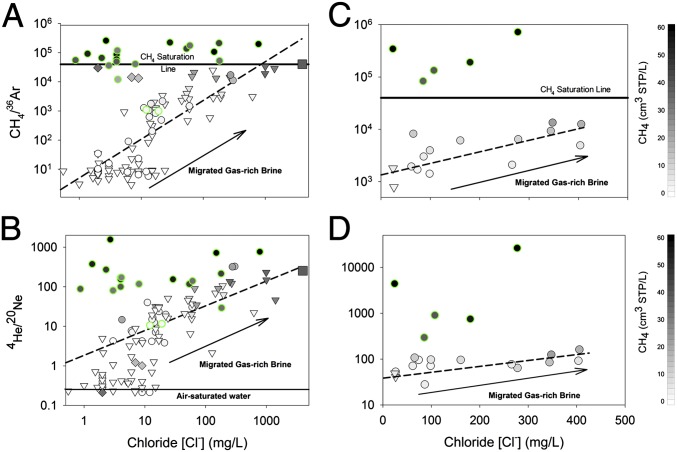Fig. 2.
The ratios of CH4/36Ar [ratios are in units (cm3 STP/L)/(cm3 STP/L); A and C] and 4He/20Ne (B and D) vs. Cl− of domestic groundwater wells. The samples were collected in the Marcellus (MSA) (Left) and Barnett (BSA) (Right) study areas at distances >1 km (triangles) and <1 km (circles) from unconventional drill sites (Tables S1 and S2). [CH4] is shown using grayscale intensity [0–60+ cm3 ([CH4]) STP/L]. The dashed lines in the MSA are the regressions of all points collected >1 km from drill sites. In the MSA, all samples >1 km from drill sites had [CH4] at or below saturation and showed significant correlations between Cl− and CH4/36Ar (r2 = 0.72; P < 0.01) or 4He/20Ne (r2 = 0.59; P < 0.01) defined as the normal trend. For samples <1 km from drill sites, one subset was consistent with the “normal trend” (P = 0.31; Chow test), whereas the other anomalous subset had supersaturated [CH4] and high CH4/36Ar and 4He/20Ne, even at low [Cl−] (green-rimmed circles in A and B). The natural Salt Spring in Montrose, PA, is shown as a square in all MSA figures, and samples targeted for microbial-sourced gases are distinguished by diamonds. In the BSA, 15 samples had [CH4] at or below saturation and significant correlations between Cl− and CH4/36Ar (r2 = 0.59; P < 0.01) or 4He/20Ne (r2 = 0.48; P < 0.01) (dashed lines in C and D). Five samples, including two that changed between the first and second sampling periods (Fig. S4), had substantially higher CH4/36Ar and 4He/20Ne independent of [Cl−]. The anomalous subset of samples from both locations with elevated CH4 that do not fall along the normal trend (>1 km) regression lines are consistent with a flux of gas-phase thermogenic hydrocarbon gas into shallow aquifers.

